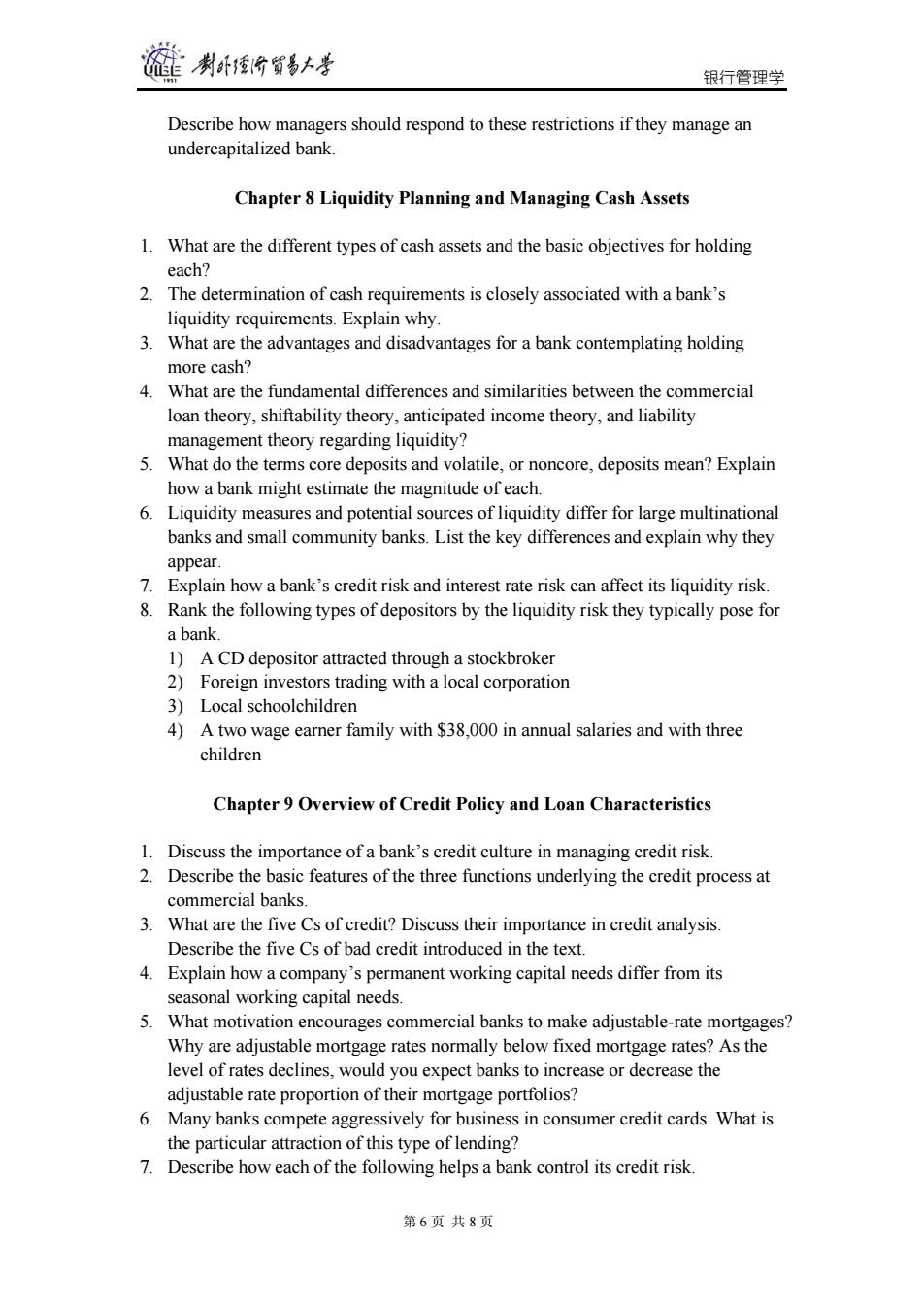正在加载图片...

莲 制卧爱分贸易土学 银行管理学 Describe how managers should respond to these restrictions if they manage an undercapitalized bank. Chapter 8 Liquidity Planning and Managing Cash Assets 1.What are the different types of cash assets and the basic objectives for holding each? 2.The determination of cash requirements is closely associated with a bank's liquidity requirements.Explain why. 3.What are the advantages and disadvantages for a bank contemplating holding more cash? 4.What are the fundamental differences and similarities between the commercial loan theory,shiftability theory,anticipated income theory,and liability management theory regarding liquidity? 5.What do the terms core deposits and volatile,or noncore,deposits mean?Explain how a bank might estimate the magnitude of each. 6.Liquidity measures and potential sources of liquidity differ for large multinational banks and small community banks.List the key differences and explain why they appear. 7.Explain how a bank's credit risk and interest rate risk can affect its liquidity risk. 8.Rank the following types of depositors by the liquidity risk they typically pose for a bank. 1)A CD depositor attracted through a stockbroker 2)Foreign investors trading with a local corporation 3)Local schoolchildren 4)A two wage earner family with $38,000 in annual salaries and with three children Chapter 9 Overview of Credit Policy and Loan Characteristics 1.Discuss the importance of a bank's credit culture in managing credit risk. 2.Describe the basic features of the three functions underlying the credit process at commercial banks. 3.What are the five Cs of credit?Discuss their importance in credit analysis. Describe the five Cs of bad credit introduced in the text. 4.Explain how a company's permanent working capital needs differ from its seasonal working capital needs. 5.What motivation encourages commercial banks to make adjustable-rate mortgages? Why are adjustable mortgage rates normally below fixed mortgage rates?As the level of rates declines,would you expect banks to increase or decrease the adjustable rate proportion of their mortgage portfolios? 6.Many banks compete aggressively for business in consumer credit cards.What is the particular attraction of this type of lending? 7.Describe how each of the following helps a bank control its credit risk. 第6页共8页银行管理学 第 6 页 共 8 页 Describe how managers should respond to these restrictions if they manage an undercapitalized bank. Chapter 8 Liquidity Planning and Managing Cash Assets 1. What are the different types of cash assets and the basic objectives for holding each? 2. The determination of cash requirements is closely associated with a bank’s liquidity requirements. Explain why. 3. What are the advantages and disadvantages for a bank contemplating holding more cash? 4. What are the fundamental differences and similarities between the commercial loan theory, shiftability theory, anticipated income theory, and liability management theory regarding liquidity? 5. What do the terms core deposits and volatile, or noncore, deposits mean? Explain how a bank might estimate the magnitude of each. 6. Liquidity measures and potential sources of liquidity differ for large multinational banks and small community banks. List the key differences and explain why they appear. 7. Explain how a bank’s credit risk and interest rate risk can affect its liquidity risk. 8. Rank the following types of depositors by the liquidity risk they typically pose for a bank. 1) A CD depositor attracted through a stockbroker 2) Foreign investors trading with a local corporation 3) Local schoolchildren 4) A two wage earner family with $38,000 in annual salaries and with three children Chapter 9 Overview of Credit Policy and Loan Characteristics 1. Discuss the importance of a bank’s credit culture in managing credit risk. 2. Describe the basic features of the three functions underlying the credit process at commercial banks. 3. What are the five Cs of credit? Discuss their importance in credit analysis. Describe the five Cs of bad credit introduced in the text. 4. Explain how a company’s permanent working capital needs differ from its seasonal working capital needs. 5. What motivation encourages commercial banks to make adjustable-rate mortgages? Why are adjustable mortgage rates normally below fixed mortgage rates? As the level of rates declines, would you expect banks to increase or decrease the adjustable rate proportion of their mortgage portfolios? 6. Many banks compete aggressively for business in consumer credit cards. What is the particular attraction of this type of lending? 7. Describe how each of the following helps a bank control its credit risk